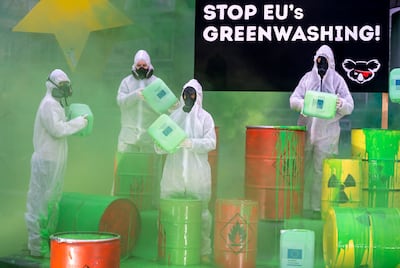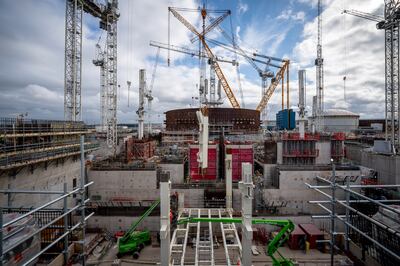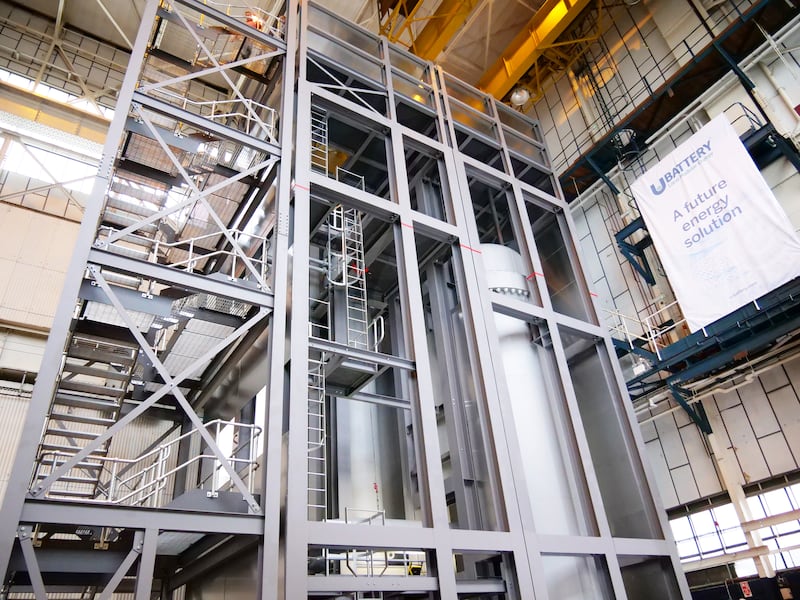It is a small invention at the heart of a big idea, a miniature nuclear plant no bigger than a windmill, which designers believe could help to solve the world’s clean energy puzzle.
For now, it is only a mocked-up prototype on display at a British workshop, but when The National toured the assembly plant its developers made no secret of their plans to reinvent atomic energy.
“We keep challenging the engineers … not to bolt on stuff to the nuclear reactor that it really doesn’t need,” said Steve Threlfall, the head of a British start-up building the uranium-fired contraption it calls a U-Battery.
The pitch goes like this. The reactor is small enough that a factory or remote community could have its own power source on site, escaping the fickle prices of the electricity grid. It could take less than two years to build, compared with a decade or more for a full-size nuclear power station.
Power companies would step in to deal with maintenance, designers think, meaning energy users would only have to pay the bill. And the reactor’s carbon emissions are basically zero – an alluring prospect for hard-to-decarbonise industries such as glass, paper and chemicals manufacturing, which rely on extreme heat typically generated by fossil fuels.
It is an attractive enough market for the U-Battery to have several competitors. But making reactors smaller does not eliminate what critics see as the fatal flaws of nuclear energy, namely that they still produce radioactive waste and conjure fears of a catastrophe.
“People have heard of Chernobyl. People have heard of Fukushima,” said Lee Whitworth, one of the engineers behind the U-Battery, at the workshop in Whetstone, Leicestershire.
Designers believe their product is virtually immune to accidents, but when a sceptical public asks questions, “we can’t just say that’s not going to happen here and walk away”, Mr Whitworth said.

Nuclear debate
The debate over nuclear power is playing out across Europe as the race to replace fossil fuels with zero-carbon energy gathers pace.
France is planning up to 14 new reactors. Germany will switch off its last three this year. The EU recently made the contentious decision to classify atomic energy as green.
French President Emmanuel Macron, who has at least nine pro-nuclear allies in the EU including Finland, Hungary and the Czech Republic, recently called for the "renaissance of the French nuclear industry" and promised a €1 billion ($1.14bn) in funding for small reactors.
The country already gets the majority of its electricity from nuclear power and last year became Europe's top power exporter, according to data analysts, supplying the UK and Italy among others.
On Germany's side of the debate, Austria and Luxembourg are planning a lawsuit against the EU's green plans, with Portugal and Denmark also among five countries who took an anti-nuclear stand at last year's Cop26 summit.
Britain sits somewhere in the middle of this spectrum, with a slice of nuclear in its power grid but offshore wind expected to do the heavier lifting in the push for net zero.
But industry insiders say ministers are on the same page on the future of nuclear energy, including on technical issues such as land zoning and insurance.
During Cop26, the UK government announced a £210 million ($284m) grant to Rolls-Royce, the luxury car maker, to build small reactors capable of powering a million homes each.
Rolls-Royce has previously built engines for the UK’s nuclear submarine fleet and, unlike the U-Battery developers, intends to supply the electricity grid with its small reactors.
It says its reactors would be bigger than the U-Battery, which is 15 metres tall but would be partially sunk underground, but last longer, with a 60-year lifespan instead of 25 to 30.
Mr Threlfall and his team have also received public funding for the U-Battery, and are hoping for more to make their £50m reactors viable on the market.
“We can’t be shutting down industry by forcing it off its current fossil fuel use into something that’s much, much more expensive,” Mr Threlfall said. “The world will never work like that.”

Britain is still building heavy-duty nuclear power stations too, including a project called Hinkley Point C, described as Europe’s largest construction site. But these are to supply the electricity grid, while small reactor makers believe there is a gap in the market for factories, mines and off-grid communities.
The U-Battery’s designers hope to supply remote communities in Canada, and would happily sell reactors to remote Scottish islands if the devolved government in Edinburgh took a more favourable view of nuclear power.
There are other players in the small reactor market abroad. In Russia, two small reactors entered operation on the world’s first floating nuclear plant, a converted barge in the country’s Arctic north.
The project was labelled an “enormous monstrosity” by environmental campaigners, who feared a lack of transparency similar to that which surrounded Chernobyl.
One American company, Ultra Safe Nuclear, has a product called a micro-modular reactor that is a direct rival to the U-Battery in aiming to supply mines, factories and remote communities.
Another US business, the Westinghouse Electric Company, hopes to have a small reactor in operation by 2025.
All these companies tout a variety of safety features which they say makes an accident implausible and giant cartoon cooling towers unnecessary.

Safety checks
At the U-Battery plant, lead engineer John Eldridge says the reactor would be so closely monitored for safety that “if a fly landed on it, you’d know”.
Nuggets of uranium fuel in the reactor would be protected by three layers of coating, he said, intended to withstand extreme conditions such as temperatures of 1,600°C.
This means the reactor would not be wrapped in “layers of safety systems”, Mr Eldridge said, although it would be encased in steel 65 millimetres thick and sealed by a 1.5-metre concrete plug, lifted once every five years for refuelling.
There is a store for spent fuel to be kept and eventually driven away, and putting the reactor partly underground is meant to reduce the risk of a plane hitting it.
But insiders admit that explaining all this to regulators is different from convincing the public that a nuclear reactor at their front door is nothing to worry about.
The company hopes to sell its first U-Battery by 2028, although the first one may look something like a porcupine with sensors attached to it to monitor its performance, Mr Eldridge said.
Designers have identified about 200 potential sites for the reactors, which could include greenhouses, mines and paper, glass, cement or ceramics factories.
They could also be used in the production of hydrogen – another opinion-splitting fuel that Europe is eyeing up as a source of jet power.
The aim is to “address a market that nuclear is not used to addressing”, Mr Threlfall said. “The world needs nuclear – big, middle and small.”







